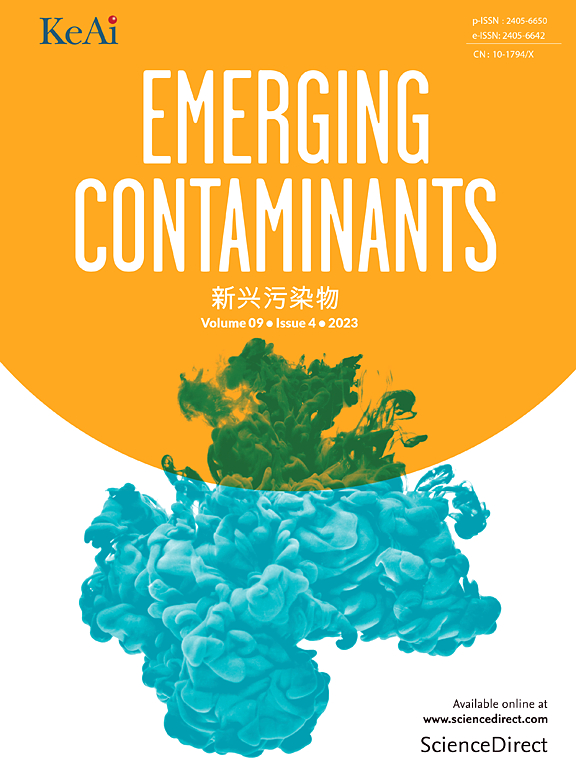Unveiling the presence of toxic transformation products and microfibers on end-of-life RO membranes
IF 6.9
2区 环境科学与生态学
Q1 ENVIRONMENTAL SCIENCES
引用次数: 0
Abstract
Point-of-use (PoU) drinking water treatment systems using reverse osmosis (RO) are becoming increasingly popular. Over time, the membrane cartridges in these systems accumulate a concentrated layer of contaminants on their surfaces. This study focuses on analysing this fouling layer by performing autopsies on spent membrane cartridges from PoU units. Four used RO membranes were collected from rural and urban locations in Kerala, India. Two of these membranes treated groundwater in rural areas, while the other two were supplied by municipal water and groundwater in urban settings. The foulants desorbed from the membrane surfaces were analysed using a combination of spectroscopic, microscopic, and chromatographic methods. Non-target analysis (NTA) revealed the presence of micropollutants, including herbicides, personal care products, and pharmaceuticals. Toxic transformation products of diuron, namely 3,4-dichloroaniline and 3,4-dichlorophenyl-N-methylurea, were also detected. Raman spectroscopy identified polyethylene terephthalate (PET) and cotton microfibers, while inorganic foulants such as calcium, iron, silicon, and aluminium were also found. Infrared spectra confirmed that the membranes were composed of polypropylene, polysulfone, and polyurethane. Improper disposal of these end-of-life membranes risks reintroducing these contaminants into the environment.

揭示有毒转化产物和超细纤维在寿命结束的反渗透膜上的存在
使用反渗透(RO)的使用点(PoU)饮用水处理系统正变得越来越流行。随着时间的推移,这些系统中的膜盒在其表面积聚了一层浓缩的污染物。本研究的重点是通过对PoU装置的废膜盒进行尸检来分析这一污染层。从印度喀拉拉邦的农村和城市地区收集了四个使用过的反渗透膜。其中两种膜处理农村地区的地下水,另外两种由市政用水和城市地区的地下水提供。从膜表面解吸的污物用光谱、显微和色谱相结合的方法进行分析。非目标分析(NTA)揭示了微量污染物的存在,包括除草剂、个人护理产品和药品。同时还检测到二脲的毒性转化产物3,4-二氯苯胺和3,4-二氯苯基- n -甲基脲。拉曼光谱鉴定出了聚对苯二甲酸乙二醇酯(PET)和棉微纤维,同时还发现了钙、铁、硅和铝等无机杂质。红外光谱证实膜是由聚丙烯、聚砜和聚氨酯组成的。对这些报废膜的不当处理可能会使这些污染物重新进入环境。
本文章由计算机程序翻译,如有差异,请以英文原文为准。
求助全文
约1分钟内获得全文
求助全文
来源期刊

Emerging Contaminants
Medicine-Public Health, Environmental and Occupational Health
CiteScore
10.00
自引率
6.70%
发文量
35
审稿时长
44 days
期刊介绍:
Emerging Contaminants is an outlet for world-leading research addressing problems associated with environmental contamination caused by emerging contaminants and their solutions. Emerging contaminants are defined as chemicals that are not currently (or have been only recently) regulated and about which there exist concerns regarding their impact on human or ecological health. Examples of emerging contaminants include disinfection by-products, pharmaceutical and personal care products, persistent organic chemicals, and mercury etc. as well as their degradation products. We encourage papers addressing science that facilitates greater understanding of the nature, extent, and impacts of the presence of emerging contaminants in the environment; technology that exploits original principles to reduce and control their environmental presence; as well as the development, implementation and efficacy of national and international policies to protect human health and the environment from emerging contaminants.
 求助内容:
求助内容: 应助结果提醒方式:
应助结果提醒方式:


